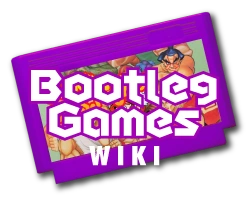TETЯIS: The Soviet Mind Game is a variant of Tetris produced by Tengen for the NES. The game was only on shelves for four weeks before Tengen was legally forced to stop manufacturing and distributing the title.
Gameplay
The gameplay is often cited as being better than Nintendo's port, as it supports 2 player mode and has more options to choose from on the menus.
Development and History
After seeing a variant of Tetris run on an Atari ST, programmer Ed Logg petitioned Atari Games to license the rights to the game. Atari Games licensed what was believed to be the legitimate arcade and console rights from Mirrorsoft, who had previously licensed them from Andromeda Software. Andromeda's belief that they could sell any arcade and console rights to Tetris stemmed from a contract between them and Elorg, the rightsholder of Tetris at the time (signed on May 10, 1988); the contract gave Andromeda the rights to Tetris for home computers and "different types of computers"; the phrase was vague enough for Andromeda to believe that it meant things like arcade systems and consoles. Atari Games, believing the rights they acquired were legitimate, began the development of an NES variant of Tetris in June 1988.[2] They announced that they were going to manufacture their own NES game cartridges in December 1988.[3]
Although the arcade rights Atari Games received from Mirrorsoft were not legitimate at the time of their arcade versions' releases, those arcade versions would eventually be legitimatized after Andromeda signed a contract with Elorg on February 26, 1989, granting Andromeda the ability to sub-license arcade rights to Tetris legitimately. The Soviet Mind Game would not get that chance, however.
On March 31, 1989, Nintendo sent a cease-and-desist letter to Atari Games that told them to stop making copies of Tetris: The Soviet Mind Game; Nintendo had acquired the legitimate console rights to Tetris directly from Elorg nine days earlier. Atari Games sued Nintendo a few days later, claiming that they had the console rights to Tetris. The court ruled in favor of Nintendo; The second version of Elorg and Andromeda's computer contract (signed on February 23, 1989) had a definition of a computer added to it, and The Soviet Mind Game did not fit the new definition. In June 1989, a month after the release of Tengen's Tetris, a U.S. District Court Judge issued an injunction barring Tengen from further distributing the game and further ordered all existing copies of the game be destroyed. As a result, 268,000 Tetris cartridges were recalled and destroyed.
In an interview, Ed Logg noted that the Tengen version of Tetris was built completely from scratch, using no source code or material from the original game. After presenting the title at the Consumer Electronics Show in Las Vegas, Tengen president Randy Browleit requested improvements in the game. Originally portrayed solely in black and white, Browleit requested that the pieces be portrayed in color, and Logg altered the game accordingly before the next Consumer Electronics Show. When asked which version of Tetris he liked the most, Logg stated the Nintendo version of Tetris for the NES "wasn't tuned right", citing a lack of the use of logarithmic tuning over doubling the game's speed.
Trivia
- This game appears often on multicarts, typically named Tetris II on the menu. Multicart versions also often omit the title screen, replacing it with a plain text title to save ROM space.
- If the reverse R on the title screen is read in Cyrillic, the game's name would be "Tetiais/Tetyais".
References
| This page uses Creative Commons Licensed content from Wikipedia (view authors). |
